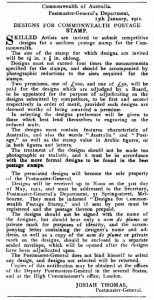[Editor: This announcement, regarding a design competition for the first nationwide stamp for Australia, was published in the Commonwealth of Australia Gazette (Melbourne, Vic.), 21 January 1911. The design which was eventually decided upon was the Kangaroo and Map stamp.]
Commonwealth of Australia.
Postmaster-General’s Department,
13th January, 1911.
Designs for Commonwealth postage stamp.
 Skilled Artists are invited to submit competitive designs for a uniform postage stamp for the Commonwealth.
Skilled Artists are invited to submit competitive designs for a uniform postage stamp for the Commonwealth.
The size of the stamp for which designs are invited will be 1⅛ in. x ⅞ in. oblong.
Designs must not exceed four times the measurements specified for the stamps, and should be accompanied by photographic reductions to the sizes required for the stamps.
Two premiums, one of £100, and one of £50, will be paid for the designs which are adjudged by a Board, to be appointed for the purpose of adjudicating on the designs submitted by competitors, to be first and second respectively in order of merit, provided such designs are deemed worthy of being awarded a premium.
In selecting the designs preference will be given to those which best lend themselves to engraving on the reduced scale.
The designs must contain features characteristic of Australia, and also the words “Australia” and “Postage,” as well as the stamp value in Arabic figures, or in both figures and letters.
The treatment of the designs should not be made too photographic or realistic, and it must be in accordance with the more formal designs to be found in the best postage stamps.
The premiated designs will become the sole property of the Postmaster-General.
Designs will be received up to Noon on the 31st day of May, 1911, and must be addressed to the Secretary, Postmaster-General’s Department, 51 Spring-street, Melbourne. They must be indorsed “Designs for Commonwealth Postage Stamp,” and if sent by post must be registered and the postage thereon prepaid.
The designs should not be signed with the name of the designer, but should bear only a nom de plume or private mark for purposes of identity, and the accompanying letter containing the designer’s name and address, as well as a copy of the nom de plume or private mark on the designs, should be enclosed in a separate sealed envelope, which will be opened after the designs have been adjudicated upon.
The Postmaster-General does not bind himself to select any design, and designs not selected will be returned.
Copies of this notification may be obtained at the offices of the Deputy Postmasters-General in the several States, and at the High Commissioner’s office, London.
JOSIAH THOMAS,
Postmaster-General.
Source:
Commonwealth of Australia Gazette (Melbourne, Vic.), 21 January 1911, p. 60 (10th page of that issue)
Editor’s notes:
Commonwealth = the Commonwealth of Australia; the Australian nation, federated on 1 January 1901
in. = an abbreviation of “inch” or “inches”; an inch is a unit of length in the British imperial system of measurement (an inch is equal to 2.54 centimetres)
indorse = (an alternative spelling of “endorse”) to write a notation or title on a document; to write a notation or endorsement on the back of a document or paper (e.g. a cheque); to sign one’s name on a document or paper (especially a commercial document); to express or give one’s approval, sanction, or support to someone or something (especially to do so in an official or public manner)
nom de plume = (French) “name of pen”, pen-name; pseudonym; an assumed name (also hyphenated: nom-de-plume)
premiate = to give or grant an award or a prize to
Leave a Reply